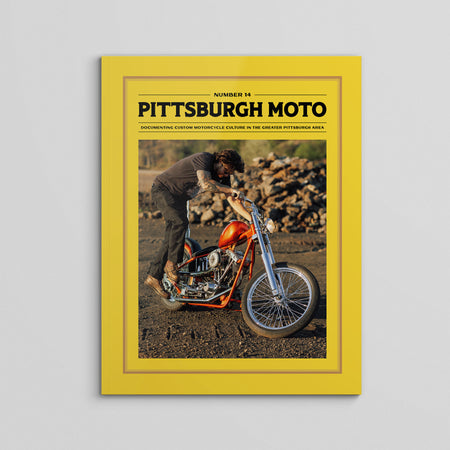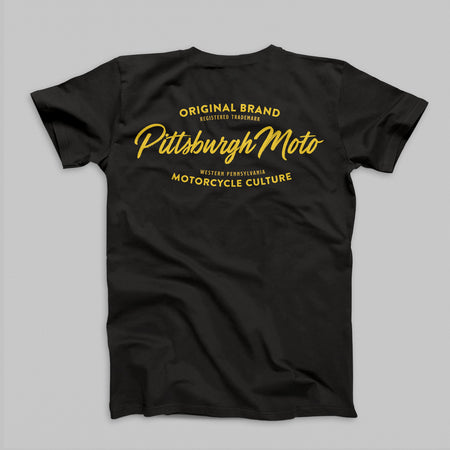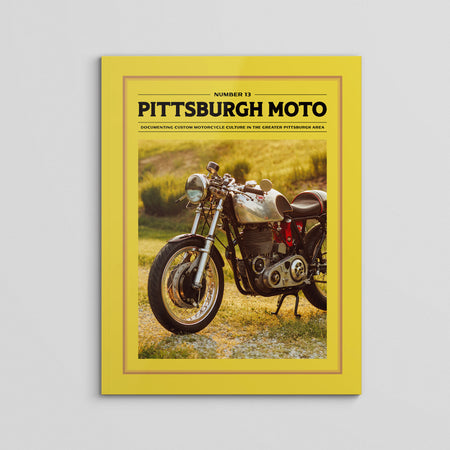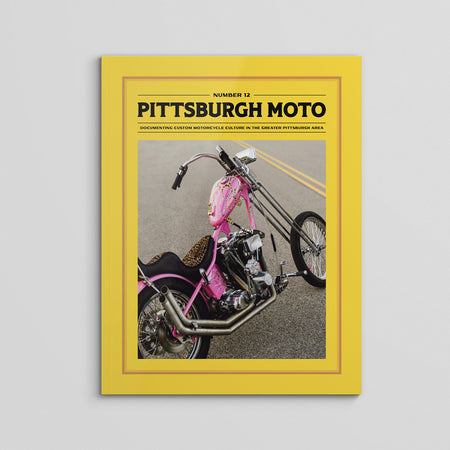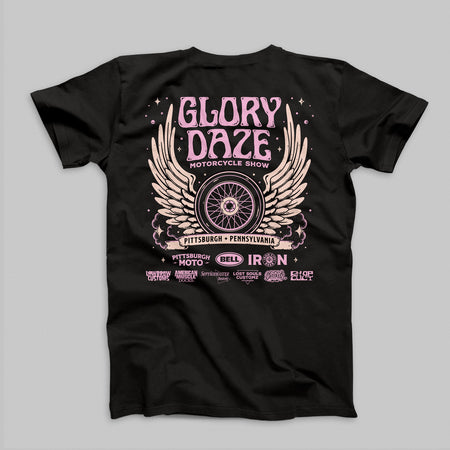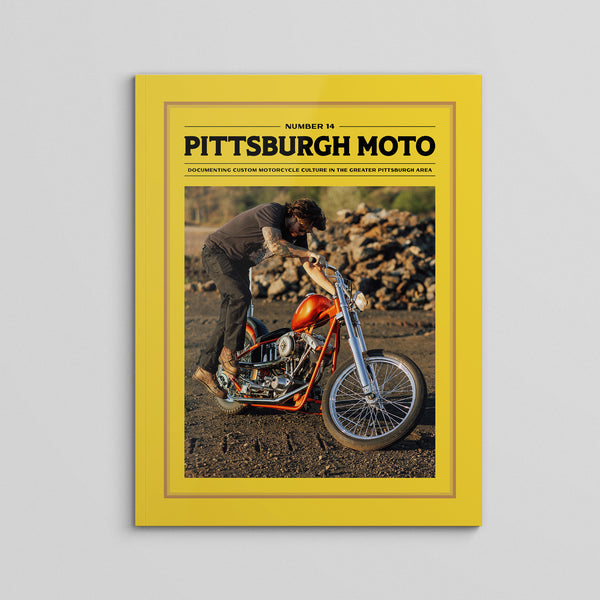
Issue Number 14
Choppers and cafe racers and drag bikes, oh my! Issue Number 14 is here with more Pittsburgh motorcycle goodness.
This is the last issue in the subscription format, but Pittsburgh Moto isn’t going anywhere. We’re going to shift the focus as a whole, putting more effort into new products and events while continuing to feature local content on our media outlets. Stay tuned for our new website and Strip District event on June 14, 2025.
Glory Daze 2024
Pre-purchase Entry Wristbands are now available!
Saturday, Sept. 21 from Noon - 7pm
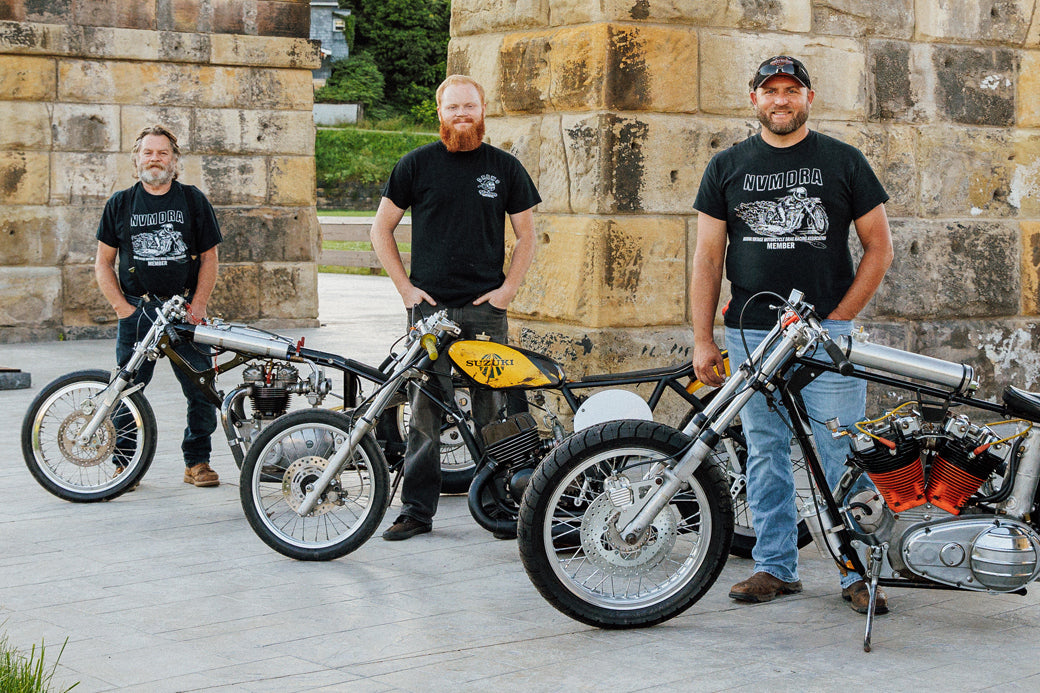
All in the Family
A Trio of Vintage Drag Racers Words by Kurt Diserio — Photos by Alexa Diserio Some hobbies are more interesting than others. In the motorcycle world, vintage drag racing holds a unique place of the industry. Chasing time on a ridiculously custom bike with an engine that’s pushed to the limit just sounds like a thrill. When we were first piecing together the 2021 Glory Daze motorcycle show, one of the featured builders was Steven Skinner of Shadyside, Ohio. Steven and his father, Wayne, brought two wild customs, a 1970 Harley Ironhead and a 1966 Triumph in a Hagon frame. Since then, Steven has been back to the show numerous times. It felt fitting to make a trip west to Ohio and check out a few dragsters worthy of a feature. The most compelling part outside of the bikes is learning how this has become a family sport that they enjoy together. They even host a race weekend every year in late August that sounds like a blast. Wayne Skinner (Triumph), Levi Phillips (Suzuki), and Steven Skinner (Harley-Davidson) Can you give the readers a brief description of the three drag racing bikes we have here?Steven Skinner: Mine is a 1959 Harley-Davidson ironhead in a 1960s Yetman frame. My stepbrother, Levi Phillips, races the full custom 1975 Suzuki TM250. Our father, Wayne Skinner, racers a 1973 Triumph with a newer Kosman frame that was made right before Kosman Specialties went out of business. That was the last Triumph frame they ever made. You have a family of racers. How did that happen?Steven Skinner: Our dad, Wayne, was into racing Triumphs back in the 1980s. It was something he did all of the time. After we were born, he didn’t get back to it until after we graduated high school. We all got involved sometime around 2010. I went straight for the speed right off the bat, racing a 1986 Suzuki GSXR at first, but I always liked the vintage stuff more since that was what he raced and wanted to do. I liked the Triumphs but was too big for them. Dad and Levi fit them nicely, but I always liked how we kept our own preference–Dad with the Triumphs, Levi in the 250cc class, and me with the Harleys. We don’t do it for prize money and all of that stuff. We just like to get out and have fun doing what these old bikes were meant to do. Levi Phillips: We have a sister and two more brothers. Our brother, Drew, runs a vintage cycle shop called Drew’s Vintage Cycles in Bridgeport, Ohio. He buys and sells bikes and parts, and ships them everywhere. All of the parts for my race bike came from Drew’s. 1973 Triumph dragbike by Wayne Skinner What is it about vintage stuff that keeps you interested?Steven Skinner: For me, it’s racing and the family thing. I like the older stuff and always have. I have my old Ford F100 truck that I drive every day and an old 1951 Chevy car. I’m more set when things are easier to work on and tune rather than plugging in a computer. Working on the stuff and feeling like you created something just feels better than installing parts. There’s a lot of tuning and personality that gets put into the bike. You make it your own.Levi Phillips: The older bikes just have more character. This Suzuki is a story on its own. I found it on Facebook marketplace for only $275 and said that even if the motor is junk, the parts would be worth that. I pulled it out of a barn that also had a Kawasaki H1, so I feel we did pretty well on that deal. Ever since then, it’s been my focus. It was a drag bike from the start, but I redesigned it with a different chassis and parts. The back half of the frame was redone. The front end used to be 55 pounds, but it’s down to 20 pounds now.Wayne Skinner: It’s just a good thing to do. You get together and have a good time. You’re still a parent when they’re running, but I’m on them about staying safe. 1959 Harley-Davidson Ironhead dragbike by Steven Skinner Where did you find the Ironhead?Steven Skinner: I found the Harley in Virginia Beach. The guy had it listed as a chopper frame ironhead. I called him up, and he wanted $5,000, but I ended up getting it for only $2,000. After I got the frame and motor, I just kind of pieced the rest together. It’s about an 83-84 inch motor that originally started out as a 1959 ironhead. I’m looking forward to running good this year. Hopefully, this newer bike does better than ones I’ve had in the past. Wayne, what pulled you towards racing the Triumphs? Wayne Skinner: I’ve just always been a Triumph guy, and I couldn’t afford a Norton. It was just the type of bike that I ran in the past when you had to deal with the Harley guy’s egos all of the time. My first new Triumph was $1,895 out the door. I’ve been with them ever since. I first got into drag racing because I was getting too many tickets on the streets. We started going to the tracks. You’d meet some people and have a good day. It’s a safe situation. You have your gear on and learn to take care of your bikes. Tell us about the race weekend that your family holds every August.Steven Skinner: The Ohio Vintage Nationals Drag Racing and Swap Meet is an event that our family started and Drew now runs. The seventh annual weekend event is August 23-25 at Freebird Dragway in Bloomingdale, Ohio. It’s an eighth-mile track. There will be camping, live music, a bike show, food trucks, and more. New or old bikes, anyone is welcome to run the track and can contact our brother Drew for more information at 740-827-0491. Come on out, it’s a good time. Levi Phillips 1959 Harley-Davidson Ironhead dragbike by Steven Skinner 1975 Suzuki TM250 full custom dragbike by Levi Phillips 1973 Triumph dragbike by Wayne Skinner Featured in Issue 14 1959 HARLEY-DAVIDSON IRONHEAD DRAGBIKE - YETMAN FRAME Built by STEVEN SKINNER 1975 SUZUKI TM250 FULL CUSTOM DRAGBIKE Built by LEVI PHILLIPS 1973 TRIUMPH DRAGBIKE - KOSMAN FRAME Built by WAYNE SKINNER Event Info: facebook.com/drewsvintagecycle Words by KURT DISERIO Photos by ALEXA DISERIO
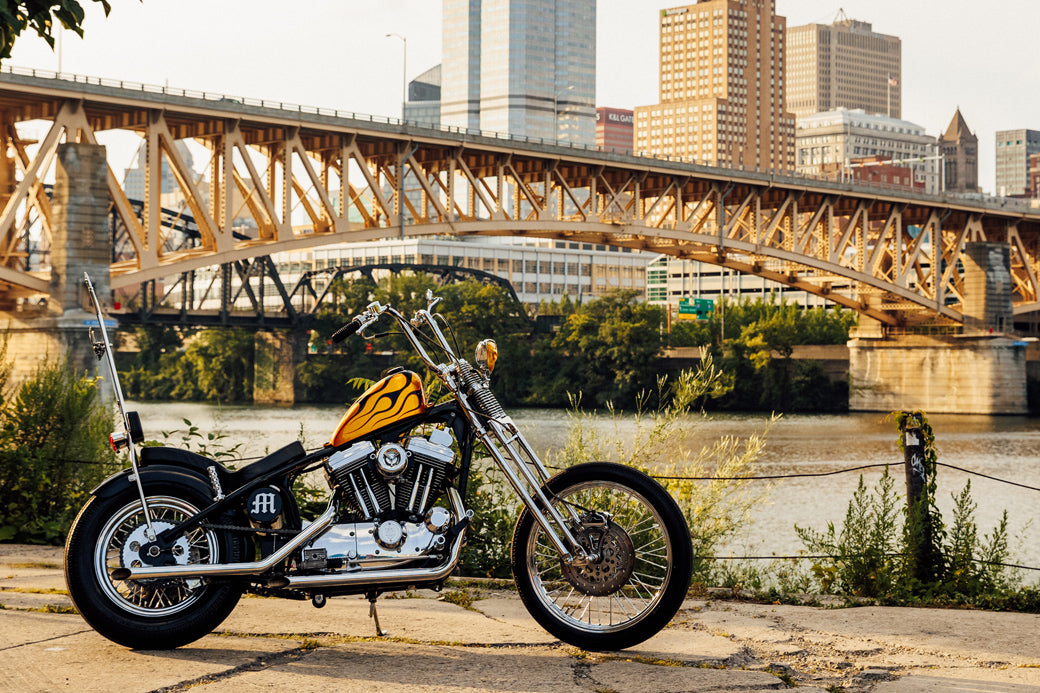
Melissa
1998 Sportster 1200 Chopper Words by Kurt Diserio — Photos by Alexa Diserio Building a chopper is as much about the bike as it is about the experience. Dan Ford, a local Pittsburgh musician, was surrounded by motorcycles in his youth but only recently finished the custom XL1200 you see here. With the help of Uptahn Metalworks, the bike started to take shape and was finished just in time for Glory Daze last year. If you picture a classic Sportster chopper build, this is something that might come to mind. The flame tank, custom sissy bar, springer front end, and overall silhouette work perfectly for a first-time chopper build. The black and yellow colors scream Pittsburgh, so we met up with Dan at The Highline on East Carson to capture a fitting background for the Steel City build. What fueled your interest in bikes?Dan Ford: When I was younger, my Dad rode but had a bad accident. My family tried to discourage me for years and years, but there were a lot of people in my life who rode motorcycles or were in clubs. I was always around the lifestyle, I guess. When I was a little kid, all of my shirts were Harley shirts. I worked at gas stations where guys would come in and fuel up for their runs. It was always a dream. Why a chopper?DF: It was a style I liked. I grew up looking over my dad’s shoulder reading EasyRider in the 1970s. Those are the bikes I love. They’re expensive and not as fun if you’re just going to buy one. I like being a little more hands-on. How did the build process go, and who helped with what?DF: I found a good deal on a Sportster and chopped the frame. I kept the engine and primary, but everything else has been changed. Almost all of the components are either TC Bros or Moto Iron parts. The headlight was a cheap internet find. The springer front end is Moto Iron. The hardtail kit, fuel tank, and oil tank are from TC Bros. I started with a king and queen seat but felt a little too confined, so I went with this one. It was swapped from a belt drive to a chain drive. Uptahn Metalworks did all of the fabrication work, including the hardtail, custom sissy bar, and more. There was some minor work done to the rear fender and oil tank. I wanted the oil tank as far back as possible to see more of the engine, so it was notched to clear the chain. Tyler Elliott of TE Customs did the paint job and fuel cap. The frame itself is powder-coated. I wanted a little more durability, and from experience with the rock chips all over my other bike, I figured what the hell. It’ll be black anyway. A deal I had with my wife to do this project was that I have turn signals. So, I got these small ones that you can barely notice. The stainless steel M pieces on the oil tank are for the bike nickname, Melissa. What was the timeline?DF: I think I started it in August 2021 and had it finished in September 2022 with time on and off. I tried to keep the project moving so I didn’t lose interest. I’d give Josh at Uptahn a lot of bits at one time while I did something else. Why the nickname?DF: The theme ties in with one of my favorite bands, Mercyful Fate. Melissa was the name of one of their records. You’re also in a band? DF: I’ve played in Pittsburgh bands for roughly thirty-two years. My current band is a grindcore project called Barbaros. Do you have a favorite road or ride to do in Pittsburgh? DF: I like riding from the South Hills through Bethel Park into the West Mifflin or McKeesport area before looping back around to the South Side on River Road. To me, that’s a fun ride. Any advice for the younger guys getting into it? DF: Seek out local shops that are reputable. Know what you’re getting into dollar-wise. Just buying the bike to start with is the beginning of the iceberg. Do your research. You’ll end up doing things to your bike that you don’t like, but don’t be afraid to try something else. Don’t worry about what’s in style, just do what makes you happy and have fun. Featured in Issue 13 1998 HARLEY-DAVIDSON SPORTSTER XL1200C Built by DAN FORD instagram Words by KURT DISERIO Photos by ALEXA DISERIO
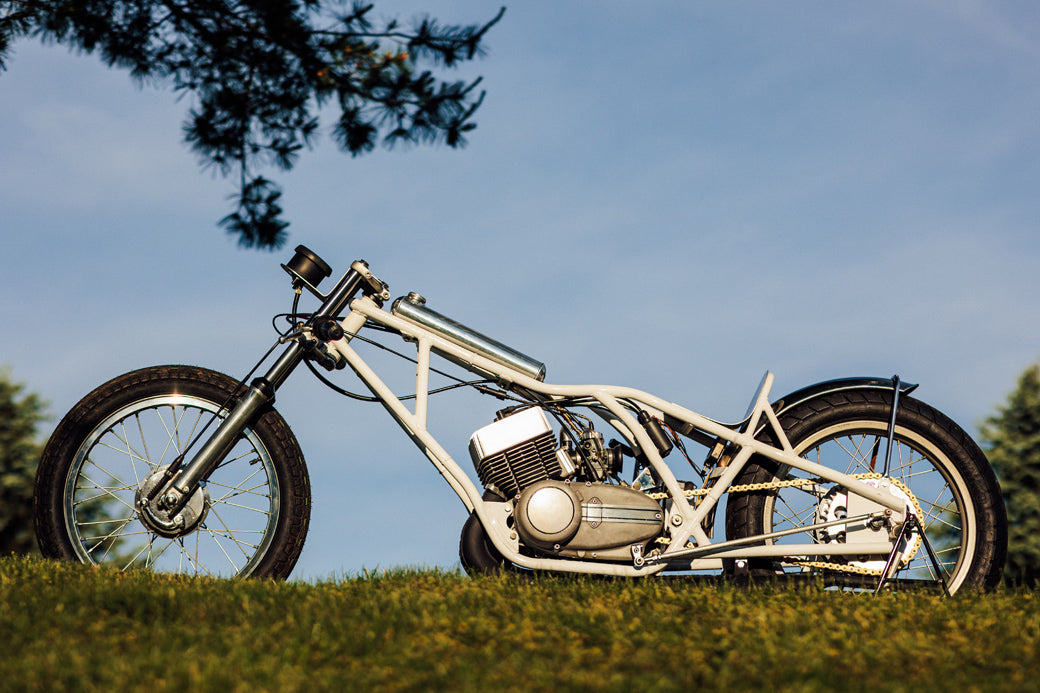
Yamaha RD250 Dragster
Two Enthusiasts Build a Two-Stroke Rocket Words by Kurt Diserio — Photos by Alexa Diserio Yamaha changed the game when it released the RD250 models in the early 1970s. They were lightweight, fast, and sounded amazing. Maybe you were there firsthand, but if not, you probably heard stories growing up about Yamaha’s racing dominance at that time. Does the name Kenny Roberts ring a bell? This particular 1975 RD250 was a dream build for two motorcycle enthusiasts who are nearly thirty-five years apart in age. Greg Mazza started riding when he was twelve years old and had collected over eighty motorcycles at one point. Now retired, he teamed up with another gearhead, Tom Pecharka, who is no stranger to vintage motorcycles, especially the Yamaha RD models. The duo set out on a goal to build a unique drag bike and win a local race. The results were better than they could have imagined, and the friendship sparked a revived passion for the sport. Can you both give a brief background on your interest in the Yamaha RD and how you met for this project?Greg Mazza: A long time ago, back in the 1970s, these bikes were becoming popular. The two-stroke, two-cylinder motors were winning everywhere–not just in drag racing but road racing, too. I got really hooked on them and figured that I’d build an RD dragster at some point. I met Tom by chance, and now, I’m preaching to the choir. He’s a Yamaha RD fanatic and has every model and part to build one. I’m a long-time motorcycle builder and retired toolmaker. We combined our ideas to come up with what we have here. Tom Pecharka: I had never done drag racing before but was set up selling vintage motorcycle parts at the Quaker City Drag Strip, which is where I first met Greg. He built a Honda CB750 dragster in the 90s and asked if I wanted to run it at the event; which we did the next year, and the bike did well on the run. The vendors there organize a “gentlemen’s race” that’s 250cc or less, so we figured why not do an RD250 and attempt to wipe the floor? That’s how this bike was born. We won that race by almost a full second. How did the build process go?Mazza: We started with a bare stock frame and started cutting and chopping. Tom lives in Canonsburg, and I live in Erie. We sent nearly 2,300 photos back and forth in the process. Because I’m up there, I built the majority of the chassis in my shop while Tom was building the majority of the motor in Canonsburg. We were able to marry them together before the gentlemen’s race last August at Quaker City. We literally got it running the week before the race. My main priority was to see him go down the track and come back in one piece. We built this together and built it to be strong. Pecharka: There was so much back and forth. I bought multiple full bikes just to get a few parts. The cradle is a stock frame, but the rest is new fabrication. It’s a stock rear hub that was lightened by machining down the center cooling fins. The center of the hub, brake plate, and sprocket carrier were drilled out. That’s a 2.5-inch wide aluminum 18-inch rear rim with spikes in the beads to keep it from spinning. We’re using a highly modified enduro front end from a Kawasaki KS125. It had a 21-inch wheel, but we swapped that with this high shouldered 1.60x18-inch rim. What other work was involved?Pecharka: There are all kinds of hand-made parts on this. Greg modified a generic oil catch can from a car to use as a temporary fuel tank, but we ended up keeping it after testing the rider position. It was perfect. We bored the top of the bottle out and welded bungs in. The wheelbase is 65 inches, which is a foot over stock. The rear fender is a Triumph front fender that we used for the old-school look. I found those original British-made clip-ons that racers would’ve run back in the mid-70s. The expansion chambers are modified RZ350 units that we removed the mufflers, added stingers, and tucked up in. We used Yamaha Banshee carburetors, intakes, and two stage reeds. This was a bit of a budget build, with the most expensive parts being the new RD250LC pistons. We didn’t use head gaskets. Instead, we cut grooves and used high-temperature o-rings. The heads were centered and pinned, so they’ll always be perfectly aligned and will have the same performance. What attracts you to two-strokes?Pecharka: The sound. Mazza: I like all motorcycles, but I love this particular engine. The RD series, whether the 250s, 350s, or even the 400s, are both good-looking and exceptional performers. Here we are, fifty years after the inception of it, and we’re winning races with it. Tom loves them, so now I have a comrade that’s into it. What is it like drag racing?Pecharka: I’ve been riding my whole life, but this was a lot different due to the rider position. People always ask how to sit on it, but you don’t really sit on it. You’re basically laying on the gas tank, but because we built it for me, it fits really well. When I go down the track, there’s no fumbling to do anything. We reversed the shift pattern, too, so it’s all down. It’s very quick that way. The bike broke into the 14s and was almost up to 90mph at the first race. How did it feel to finish the build?Mazza: It was a lot of fun and fulfilled a dream. The best part is that it went down the track straight the first time. It stopped well and didn’t have any issues. I got to build the bike I always wanted to build, and it’s good to do it with someone I’m very close to and have a lot of respect for who happens to be thirty-five years younger than me. It’s usually just me doing it, but it’s good to have a partner. It makes me excited about the future and gives a little fire to an old guy who has all of this knowledge and wants to use it. Tom’s a perfectionist and he does things right. Featured in Issue 13 1975 YAMAHA RD250 Built by TOM PECHARKA + GREG MAZZA Words by KURT DISERIO Photos by ALEXA DISERIO
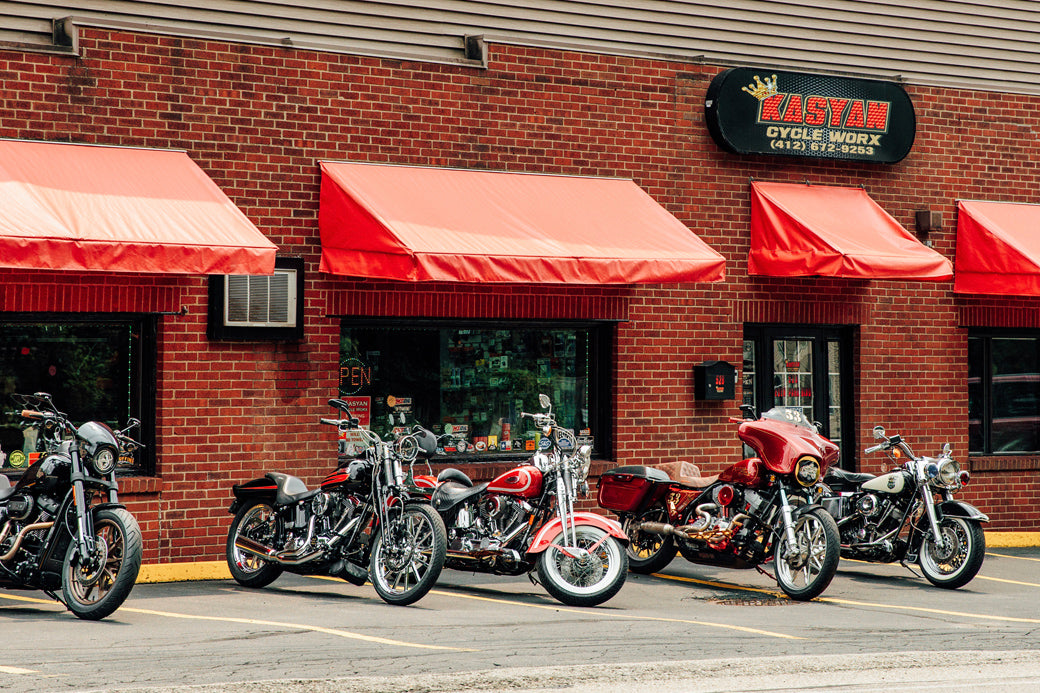
Kasyan Cycle Worx
A Family-Owned Shop Hits the Ten-Year Mark Words by Kurt Diserio — Photos by Alexa Diserio It’s not easy running a business or being self-employed, especially with how things have been changing. Rent is out of control and the cost of things has increased comically. Pittsburgh has lost a few bike shops and dealerships since 2020, so it’s refreshing to know that the local Kasyan Cycle Worx is still going strong. The father and son team of Nick and Jordyn Kasyan recently moved into a new building in McKeesport, where they have a lot more room and easy street access. Walking into the back was impressive, with almost every bike lift being occupied by a customer’s bike or one of their own custom builds. We learned the backstory of how Nick got things started with the shop and how his son, Jordyn, picked up on mechanic skills at such a young age. How did you get the business going?Nick Kasyan: I started with cars. In 2004, a buddy that I went to school with had parents who owned Heritage Harley-Davidson, so I had an opportunity to go up there and give it a shot. It worked out, and I’ve been doing motorcycles ever since then. In 2013, I opened our first Kasyan Cycle location in a two-car garage in an alleyway. From there, we moved to our Fifth Avenue location. The only reason we ended up moving from there was that the owner wanted to sell the building. We started looking for other spots and stumbled upon this McKeesport location. It’ll be a year in August in this building. Was there something that motivated you to open your own shop?Nick: I didn’t know what I wanted to do. I was doing part-time work at the time because I had young kids and a family. I bought some parts from a guy out by Wicked Witches in Natrona Heights. He had a double-decker garage with maybe twenty-five used bikes for sale upstairs and did the service work downstairs. That inspired me to do my own thing. Ten years in, and we’re just now getting bikes to buy and sell. We’re at that point where we’re steady with bikes and trying to buy and sell as much as we can. Jordyn, when did you start working with motorcycles?Jordyn Kasyan: I’ve been doing this full-time since I was maybe thirteen or fourteen. I’m seventeen now. Was your red, white, and blue Sportster your first custom bike?Jordyn: It’s a collection I’ve accumulated throughout the years. I’ve been building bikes since I was a kid but was more of the bastard stepchild of the guys who were doing their cars. I did some knuckleheads, panheads, and all kinds of stuff. I grew up around motorcycles, so the parts were always around. How does it feel to be involved with a craft so intricate and mechanical at a young age?Jordyn: I have always had a motivated mind and was never huge into video games or stuff like that. I’m a mechanical type of person that has always torn things down and worked on stuff. Even when I was little with RC cars. Although it sucked, Covid actually helped because it gave me the opportunity to be able to work full-time. I was always down here after school, even just sweeping floors. What style of bike or type of work do you both prefer?Nick: We service all bikes, but we’ve been getting more into the performance baggers and softails. You kind of have to chase the trends in this market to survive. Jordyn: We definitely both found a passion for the performance side, especially as it picks up in the area. We’d like to start stepping into having more bikes for sale and parts in inventory, even our own built bikes for sale. More eye candy but keep the everyday operation going. How would you describe Kasyan Cycle Worx to potential customers?Jordyn: We guarantee our work and will stay late to get it done if that’s what it takes. Our biggest thing is to be fair with the customer. Nick: We’re family-owned and give a fair price with a good product. We have customers from all over, even one that brings his bike from Tennessee for service when he’s visiting family in the city. If I’m not touching it myself, I’m keeping an eye on things. Would we like to charge more? Of course, but I like to keep things as fair and affordable as we can. That’s how we’ve made it for ten years. Note: Starting in March 2024, Kasyan Cycle Worx will be operating out of their new location at 101 5th Ave, McKeesport, PA 15132 Featured in Issue 13 KASYAN CYCLE WORX 101 5TH AVE, MCKEESPORT, PA 15132 412-672-9253 www.kasyancycleworx.com facebook | instagram Words by KURT DISERIO Photos by ALEXA DISERIO
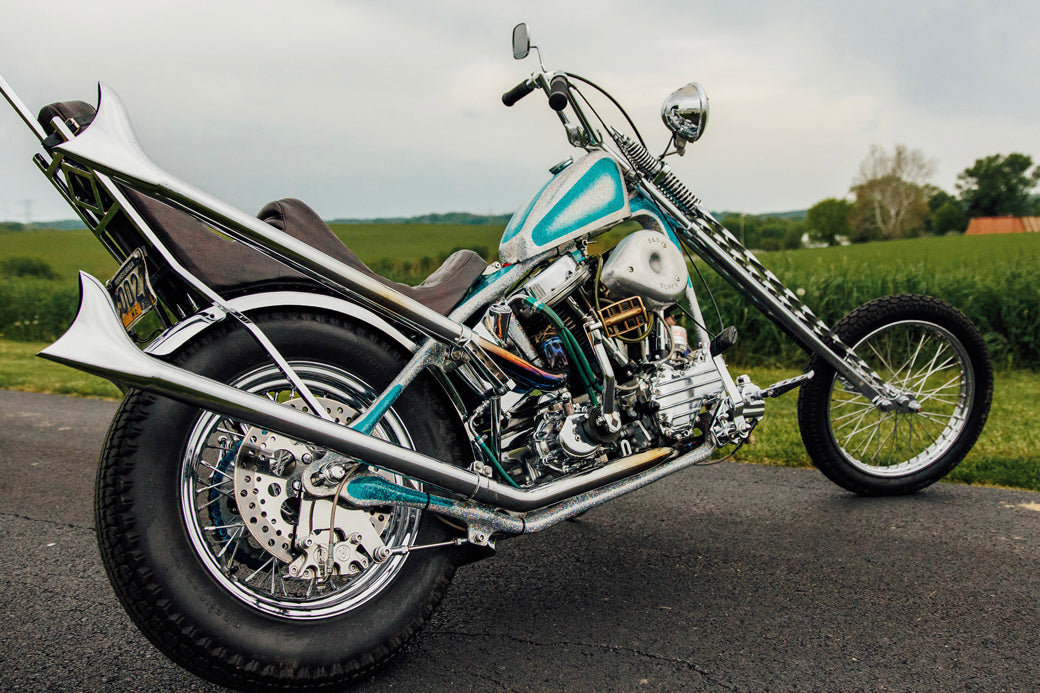
1956 Panhead Chopper
The Nature of the Beast Words by Kurt Diserio — Photos by Alexa Diserio We’ve had numerous people over the years approach us about seeing cool custom motorcycles riding around Hookstown, Pennsylvania. As it turns out, no matter which bike it was, they were almost always talking about Harry Dykes. As someone who bought his first bike at age fourteen, it was no surprise to learn about the many classic motorcycles that have passed through his garage over the years. With its heavy paint flake and laid-back stance, the tried and true 1956 Harley-Davidson pictured here is a great representation of classic chopper culture that could have come straight from the 1970s. As you’ll read, that was exactly the result he was aiming for. We met up with Harry in the hills of Hookstown to hear more about his past and how the bike took shape. What impact did your childhood have on this build?Harry Dykes: Whenever I was a little kid in Hookstown, a friend’s aunt’s husband had a 1967 Triumph Bonneville chopper. I remember sitting on the bike when I was a kid, maybe as young as ten years old, and playing the whole motorcycle fantasy thing. There was a TransAm sitting next to it, and my friend would sit in the car while I was on the chopper. We’d just bullshit and hang out, kid stuff. The owner of the bike passed away, but I ended up with the seat, gas tank, and sissy bar from that Bonneville and held onto the parts for twenty years. I’ve had several bikes through the years, starting with British bikes—a few different Triumphs, a BSA for a while, a couple of ironheads, and a shovelhead that I’ve had for ten to twelve years now. I told myself that I’d eventually build a panhead and use those pieces, and here it is. It took twenty years, but those parts were off of the bike that first got me into choppers. How did you get this build rolling?HD: My dad was looking for a trike, and I knew a guy selling a 1947 Servi-Car. He also had a panhead engine, and I ended up getting him to throw it in on the deal. My original plan was to just toss a quick chopper together, but then ended up splitting the cases, hand sanding and polishing everything, and it just kept snowballing from there. The first night that I started sanding it, I asked myself, “Why the hell did you do this?” What did the process look like once you got into it?HD: I had countless hours hand sanding and polishing everything until my fingers were gone. The original paint job was commissioned, but after seeing the painter do another identical bike, I figured I’d just do it myself so I had something that was one-off. I wanted it to look like you pulled it off of a 1970s chopper. That’s a Jammer frame that I molded. I figured that if I was polishing shit, then I might as well start molding, too. It was beat up and in rough shape when I bought it from a guy in Akron. I used to run a 20-over P&P girder, which is what was on it for Glory Daze 2022. It rode decent at highway speed but had tire flop when riding around town. I ended up finding that 15-over front end and threw on an 18-inch wheel. It rides like a dream. You can take your hands off the bars and light a cigarette going down the road. What attracted you to building a bike from this period? HD: I was brought into motorcycles by a bunch of older guys that were into bikes when I was younger. They grew up in the 70s riding shit when it was first coming out. That’s what got me into riding and enjoying bikes. I’ve always been partial to the older choppers because I’d hear them reminiscing about riding their bikes to California or pogo-sticking across two lanes of the highway. Well shit, I want to do that. Nobody in my family was into motorcycles, but when I was fourteen, I bought a 1959 Triumph Daytona that was chopped out. This was the pre-internet era, and I went through hell getting parts for it. I’ve had a bunch of different style bikes but just can’t seem to get away from choppers. What does the bike mean to you now?HD: It used to have a telescopic front from the 1960s, but I picked up this Denver’s Choppers front end from Cycle Warehouse in Butler, Pennsylvania. My brother and I went up there in the winter one year, and after looking around, I saw that they had a bunch of springer front ends on the wall. I took some measurements on my bike and went back in the springtime. It was still there, and I got a better deal by waiting. It was perfect for the bike. I didn’t really want to run a 21-inch front wheel, but it gives the chopper the right stance. What are your typical rides like?HD: I try to keep it mostly local but will run a couple of hours in any direction. As far as long trips go, I try to but it’s hard to get anyone that wants to join in. Personally, I just like to get out and ride, whatever the destination. Anything else you want to say about it?HD: That engine is kind of the reason I stuck with the show bike thing. My dad passed away, but he would always break my balls and say I would never finish it once I started polishing it. So, I wanted to prove that I could do it. Featured in Issue 13 1956 HARLEY-DAVIDSON PANHEAD CHOPPER Built by HARRY DYKES instagram Words by KURT DISERIO Photos by ALEXA DISERIO
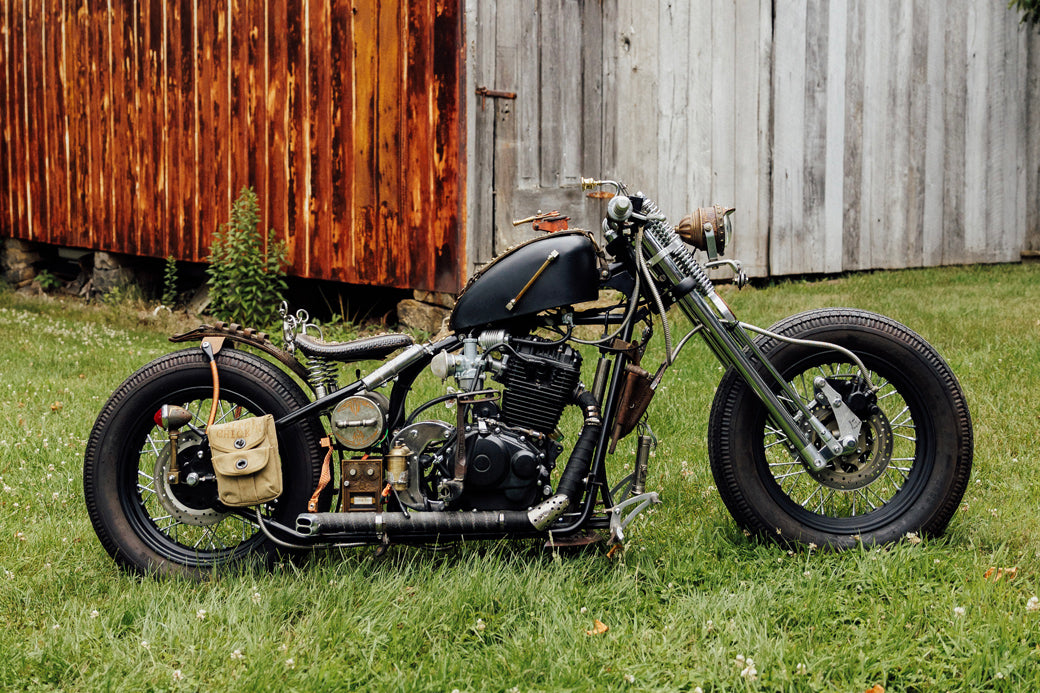
Ditch Chicken
Old Junk Becomes Moving Art Words by Kurt Diserio — Photos by Alexa Diserio This motorcycle demands your attention. You could look at it for hours trying to figure out what all of the parts are or where they came from. For instance, the brake fluid reservoir is actually a brass mill grinder from Croatia. As the bike’s builder, Jerry McGinty, put it, “The machine is a rolling amalgamation of steel, glass, brass, copper, leather, rust, bamboo, silver, stainless, and Ti.” We first saw this wild creation at the Mods. vs. Rockers event last year and reached out to the owner, Estle Harp, about including it in Glory Daze that September. The fun bike garnered a lot of attention throughout the event. We felt it needed a proper feature, so we met up with Estle at his place in Butler to learn more about the work involved and what it means to own such a unique, one-off custom motorcycle. This is an extremely interesting motorcycle. Who built it, and how did you end up with it?Estle Harp: Jerry McGinty built it. He lives a little west of Erie, Pennsylvania. I saw him at the Cafe Racer show one year. He brought a few other bikes down there through the years, so I asked him if he’d ever thought about selling any of his bikes. I fully expected him to say no, but he said that he was thinking about it in order to make some room in the garage for new projects. The only condition is that I’d have to buy all four of his custom builds. Jerry really wanted them to go to someone who would appreciate them. I told him that he was looking at the guy. He’s a really nice guy who is very creative. He just proves to not throw anything away because it could become useful at some point. Are all four of the bikes you bought different from each other? EH: They’re similar in style but use their own pieces. The only thing that’s the same is the motor and frame. I’d have to say that this is my favorite of the four. It was the last one built, and he obviously put a lot of time and thought into it. When did your motorcycle obsession get started?EH: I probably got into bikes about fifteen-to-twenty years ago. I was a big Honda guy and had way too many bikes. I had over fifty Hondas at one point, but it was too much to take care of. So, I started selling a bunch of them here and there–some I wish that I hadn’t sold. I had two Honda police bikes from the 1960s. I swore that I wouldn’t sell them, but someone offered me the right price, and they went to South Africa. Are you originally from the Butler area?EH: I grew up in Allison Park but moved out here in 1986 and started the Fun Park. It used to have a go-kart track that we ran for thirty-one years. Now, we just run the mini golf. What made you buy the bikes, this one in particular?EH: I just have an interest in creative things. Stuff like this only comes along once in a while. To me, it’s a piece of art, and I’m really grateful to own it. I feel fortunate because you know he put his heart and soul into that thing. What motor and frame is this?EH: It’s similar to a 200cc Honda, basically a Chinese clone. The frame is from a company in California called Kikker. I think they make the front end, too. What odd pieces were used throughout the motorcycle?EH: The handlebars are a turnbuckle. The mirror is from a brass candlestick. The kickstand is a wood-boring bit. The tail light is from an old amusement park ride. The license plate bracket is a cheese grater. It uses an old car jack for the center stand. The tank bib was fabbed from a fancy horse tack. Jerry said he was at an auction somewhere, and some young Amish kid bought a whole bunch of tack. His dad said it was too fancy, and he wasn’t allowed to have it. So, the kid sold all of it to him for five dollars. Do you have any favorite parts?EH: I really like the mailbox door used on the battery box. Also, the back side of the headlight is from a gas light out of an old house, and the center part of the headlight is an old, rusty four-inch sewer pipe. The footpegs are tree-climbing spikes. They hurt, too, because I cranked my ankle off of one. It made me dance. What does it mean to see someone put together such a creative motorcycle?EH: He kind of inspired me to maybe do a couple of my own. I have all kinds of junk around here that I could use. Featured in Issue 13 2011 KIKKER HARDKNOCK Owned by ESTLE HARP Built by JERRY MCGINTY Words by KURT DISERIO Photos by ALEXA DISERIO

